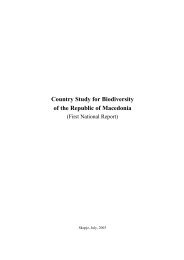CBD Fourth National Report - Azerbaijan (English version)
CBD Fourth National Report - Azerbaijan (English version)
CBD Fourth National Report - Azerbaijan (English version)
You also want an ePaper? Increase the reach of your titles
YUMPU automatically turns print PDFs into web optimized ePapers that Google loves.
Country Study on Biodiversity and <strong>Fourth</strong> <strong>National</strong> <strong>Report</strong><br />
The Republic of <strong>Azerbaijan</strong><br />
• Land degradation, resulting from overuse, erosion and fertilizer burdens reduces<br />
productivity and affects the likelihood of natural habitats reestablishing. It is estimated<br />
that 70% of pastures have undergone erosion, particularly the more fragile summer<br />
pastures.<br />
• Pesticide use, particularly the legacy of high levels of application of toxic chemicals<br />
during the Soviet era, has resulted in long term pollution of some soils, and leaching into<br />
waterways. Pesticide use is currently under improved State control, however some illegal<br />
application of imported and unregistered pesticides is thought to occur.<br />
• Irrigation has impacted much of the lowlands, and canals have fragmented much of the<br />
wider natural habitat, preventing free migration of animal species (especially as they lack<br />
appropriate bridges or escape paths for wildlife). Over recent years the collapse of these<br />
systems due to lack of repair has resulted in changes in the chemical composition of soil,<br />
increase in the ground-water level and gradual increases in salinity in some areas.<br />
• Water regulation, including the construction of dams and management of water flows<br />
and extraction levels, has affected aquatic habitats significantly, particularly in the absence<br />
of adequate measures for protection of fisheries and other aquatic species<br />
• Pollution, including the legacy from Soviet industry and agriculture, and ongoing<br />
pollution of waterways from domestic and industrial sources. In some cases older<br />
infrastructure relating to the oil industry is a source of pollution. The outflow of rivers into<br />
the Caspian Sea contributed to the pollution loads detected in the marine habitat.<br />
• Transport infrastructure (including over 2,000 km of railway, 25,000 km of roads and<br />
4,000 km of oil and gas pipelines) has caused habitat fragmentation, and represent barriers<br />
to the movement of wildlife, resulting in genetic isolation of sub-populations.<br />
• Over-use of biological resources has been ongoing, with difficult economic conditions<br />
resulting in overexploitation of forests, medicinal plants and animals (including fish). Of<br />
particular note has been the decline in fisheries from both the Caspian Sea and inland<br />
waterways as a result of over-catch along with other factors such as water extraction and<br />
pollution. The sturgeon issue is one that requires international collaboration in order to<br />
prevent further over-fishing.<br />
• Invasive species. Delivery of Mnemiopsis leidyi into the Caspian sea caused to extinction<br />
of tens of alevins and generally, feed provision of fishes.<br />
Regarding plants adventitious weedery such as ambrosia artemisiifolia L, cuscuts L.,<br />
acroptilion repens DC., solanium rostratum Dun spreaded out in countrywide flora and<br />
squeeze out thelocal species seriously.<br />
• Climate changes. Global climate changes effect to countrywide biodiversity in any<br />
extent. As a result of overall climate warming, biodiversity more undergoes effect of<br />
stress factors by rising up of humidity index in some arid areas and by declining of<br />
cloudage and moisture in other areas, at the same time climate changes result in serious<br />
change of hydrological regime of many rivers and lakes that it adversely impact upon<br />
water bioresources.<br />
1.2.3. Underlying causes of biodiversity loss<br />
A range of issues drive the ongoing decline of biodiversity in <strong>Azerbaijan</strong>, as in the rest of the<br />
world:<br />
• Economic development. Over the last decade the Republic of <strong>Azerbaijan</strong> has seen major<br />
social and economic change, resulting from independence, economic downturn, and<br />
subsequent market reforms and recovery. The legacy of Soviet overuse of natural<br />
resources persists with regard to high pollution and pesticide burdens. In addition, the<br />
56<br />
2009

















